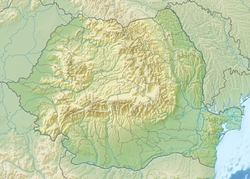Parța Neolithic Sanctuary
| Location | Parța |
|---|---|
| Region | Romania |
| Coordinates | 45°37′25″N 21°06′50″E / 45.62361°N 21.113889°E |
| Type | Shrine |
| History | |
| Periods | Neolithic |
Parța Neolithic Sanctuary refers to an excavated Neolithic cult-centre or shrine located on the right bank of the Timiș River at Parța, south of Timișoara, in Romania.
Description[edit]
The sanctuary has been dated to around 5000 BC and is considered part of the Vinča culture.[1] It is part of a wider complex of buildings and domestic settlement.[2] The sanctuary building had raised altar-like pedestals and life-size figurine heads together with specially built granary areas.[3] Statues consisted of large clay humanoid figures.[4] A life-sized sculpture of a double-headed goddess stood near the entrance.[1] One of the smaller humanoid figures has horns.[5] The finds strongly suggest a local bull-cult, as bull's horns are present everywhere in the sanctuary,[5] and cattle skulls were placed on a clay platform.[4]
Finds from the excavations, together with a reconstruction of the sanctuary, can be found in the Museum of Banat in Timișoara.[2]
References[edit]
- ^ a b Gimbutas, Marija; Robbins Dexter, Miriam (2001). The Living Goddesses. University of California Press. p. 76. ISBN 0520229150.
- ^ a b Gimbutas, Marija (2007). The Goddesses and Gods of Old Europe, 6500-3500 B.C.: Myths and Cult Images. University of California Press. p. 250. ISBN 978-0520253988.
- ^ Jones, Andrew (2008). Prehistoric Europe: Theory and Practice. Wiley & Sons. p. 132. ISBN 978-1405125970.
- ^ a b Russell, Nerissa (2011). Social Zooarchaeology: Humans and Animals in Prehistory. Cambridge University Press. p. 344. ISBN 978-1139504348.
- ^ a b Drașovean, Florian; Popovici, Dragomir; Wullschleger, Manuela (2008). Neolithic art in Romania. Historisches Museum Olten. p. 39.

